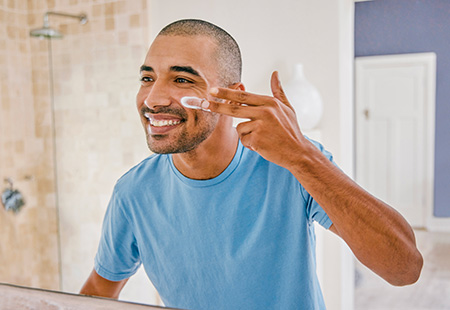Multicultural dermatology: Treating skin, hair and nail conditions in people of color
UC Davis expert explains why it’s important to seek appropriate care for skin of color
As the United States becomes increasingly more diverse, a growing number of patients are seeking specialized dermatologic care for skin and hair conditions unique to their ethnic backgrounds.
As a result, people of African, Asian, East Indian, Hispanic, and Middle Eastern origin, among others, are actively seeking multicultural dermatological care. Providers who work in multicultural dermatology are specially trained to diagnose and treat skin, hair, and nail conditions in people with skin of color.
In this Q&A, Director of Multicultural Dermatology and Hair Disorders, Oma Agbai, who often shares skin and hair advice on Instagram @dr.oma.agbai, discusses important considerations when seeking care for skin of color.
What is skin of color?
Skin of color is defined more by the behavior of skin in response to sun exposure than by ethnic origin. Individuals with skin of color, such as those of African, South Asian, Hispanic, East Asian, and Middle Eastern descent, are more likely to tan with extended sun exposure and rarely or never experience a sunburn. Characteristically, these are individuals with olive to dark brown skin colors.
Are there differences in the biology of skin of color?
Skin of color is a very broad term that includes a wide variety of skin colors of people with different ethnic backgrounds. Skin pigmentation is the biggest difference. Interestingly, a person with dark skin has the same number of melanocytes (melanin-producing cells) in the skin as someone with very fair skin. The difference is that individuals with darker skin types produce more melanin (natural pigment), which is more broadly distributed across the outermost layer of skin, called the epidermis.
Melanin protects epidermal skin cells from UV-related damage, reducing the risk of sun-induced wrinkling, pre-cancers, and skin cancers in people of color.
What are some common misconceptions about skin of color?

There are patients with dark skin who believe that they do not need sunscreen because they are unlikely to develop a UV-induced skin cancer. This is certainly not true. I have had patients of all skin colors develop skin cancers related to UV exposure, such as squamous cell carcinoma, basal cell carcinoma, and melanoma.
It is rare to diagnose a person of African descent with melanoma. However, when the diagnosis is made in this ethnic group, melanomas have been shown to be at a more advanced stage, with worse outcomes than in fair-skinned individuals of European descent diagnosed with melanoma.
It is important to note that in people of African descent, melanomas are more likely to develop on the palms of the hands and soles of the feet, rather than high-sun-exposure areas such as the face. Remember reggae legend Bob Marley? He tragically died of a metastatic melanoma that developed on his foot.
What is the number one skin care issue people with ethnic skin experience?
Hyperpigmentation is one of the most common skin conditions diagnosed in my patients of color. It is a medical term describing dark patches or spots that develop on the skin at the site of a condition such as acne, a burn, or eczema.
How is hyperpigmentation treated?
There are several topical creams which can prevent or treat hyperpigmentation. Look for creams with specific ingredients such as hydroquinone, azelaic acid, tretinoin, or cysteamine. The key to success is to be consistent and patient, as daily treatment for at least two months is often required to see a noticeable improvement.
Hyperpigmentation can also be treated with cosmetic procedures such as superficial chemical peels and gentle laser treatments.
It is vital to work with a board-certified dermatologist when being treated for hyperpigmentation, as certain cosmetic procedures, and even topical creams, can worsen hyperpigmentation.
Are there ingredients in skin care products that people with skin of color should avoid?
Medium or deep peeling agents such as trichloroacetic acid should be avoided. This is available over the counter, so do not assume that because a product is sold without a prescription or doctor’s visit that it is safe to use. These agents can cause severe hyperpigmentation and scarring in skin of color.
Furthermore, overusing superficial peeling products containing alpha hydroxy acids (such as glycolic acid) can also irritate the skin, worsening hyperpigmentation.
Patients of color should not be discouraged if they have been told that nothing can be done for their skin condition. There are several medical and procedural options for the treatment of a wide variety of skin conditions in people of color.” —Oma Agbai
What are common errors people with skin of color make regarding skin care?
Scrubbing or exfoliating the skin to reduce blackheads can worsen acne by irritating the hair follicles. Scrubbing the skin can also worsen hyperpigmentation.
Picking the skin can also worsen hyperpigmentation, scarring, and even induce raised scars such as keloids.
Are there treatments that may not be a great fit for people with skin of color?
Certain laser treatments, micro needling, and chemical peels are safe to use in people of color. The key is to work with a board-certified dermatologist who is experienced in treating darker skin types.
Stronger laser treatments such as complete facial resurfacing with CO2 laser should be avoided in darker skin types due to the risk of hyperpigmentation and scarring.
Lastly, I want to emphasize that patients of color should not be discouraged if they have been told that nothing can be done for their skin condition. Many of my patients tell me that they have heard this in the past. There are several medical and procedural options for the treatment of a wide variety of skin conditions in people of color.





